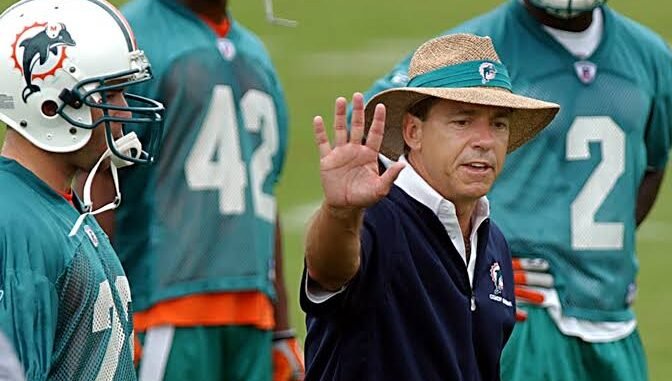
Twenty years have passed since Nick Saban took the reins as head coach of the Miami Dolphins. Recently, Saban shared his thoughts on the experience, labeling it a “no-win situation.” He made these remarks on the Pat McAfee Show, where he also discussed the importance of carefully evaluating a team’s roster and circumstances before accepting a coaching position.
Saban emphasized the need for coaches to scrutinize the roster, salary cap, and quarterback situation before taking on a new role. He cited his own experience with the Dolphins as an example, highlighting the numerous challenges he faced upon arrival. Saban noted that the team was $17 million over the salary cap, had the oldest roster in the league, and lacked a capable quarterback.
Despite these obstacles, Saban’s Dolphins managed to secure a winning season in his first year. However, the team’s long-term prospects were hindered by the absence of draft picks, which had been traded away in the acquisition of Ricky Williams. Saban stressed the importance of conducting thorough research before accepting an NFL coaching position, underscoring the risks of inheriting a flawed roster.
Saban’s tenure with the Dolphins was marked by quarterback issues, which ultimately proved insurmountable. Upon his arrival, the team’s quarterback corps consisted of Jay Fiedler and A.J. Feeley. Saban opted to use the second overall pick in the 2005 draft on running back Ronnie Brown, rather than selecting a quarterback. This decision has been scrutinized in hindsight, particularly given the success of Aaron Rodgers, who was drafted 24th overall.
Instead of selecting a quarterback, Saban chose to rely on veteran signal-caller Gus Frerotte. Despite initial doubts, Frerotte performed admirably, helping the Dolphins rebound from a 3-7 start to finish the season with a 9-7 record. However, the quarterback woes persisted, and Saban’s subsequent attempts to address the issue ultimately proved unsuccessful.
The following offseason, Saban’s Dolphins were involved in a high-profile pursuit of quarterback Drew Brees. However, the team ultimately failed to secure Brees’ services, instead trading for Daunte Culpepper. This move failed to yield the desired results, and the Dolphins struggled to a 6-10 record in Saban’s final season.
Saban’s departure from the Dolphins was marked by controversy, as he spent the final month of the season denying rumors that he would leave to take the head coaching position at the University of Alabama. Ultimately, Saban did indeed make the move to Alabama, where he has since established himself as one of the most successful coaches in college football history.
In retrospect, Saban acknowledges that he underestimated the challenges he would face in Miami. He attributes his decision to take the Dolphins job to a “bad case of the dumb ass,” while also expressing admiration for the team’s owner, Wayne Huizenga. Despite his regrets, Saban maintains that he thought the Dolphins organization had the potential to be successful, but ultimately, the quarterback issues proved insurmountable.

Leave a Reply